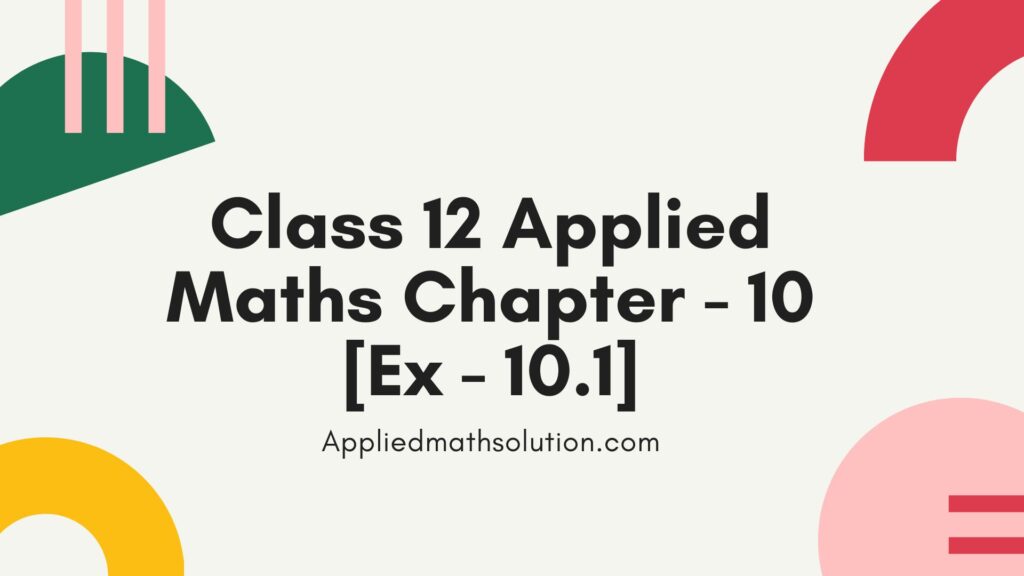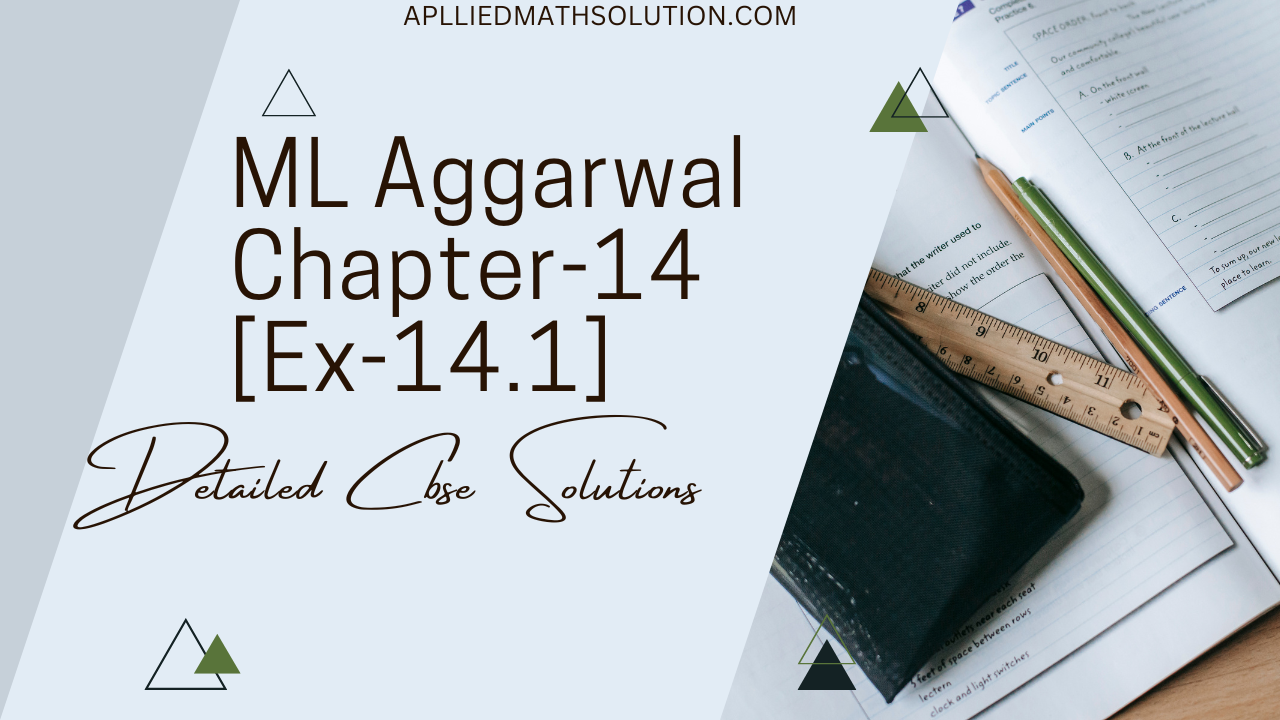Welcome to Class 12 Applied Maths Chapter 10, where we embark on an exciting journey into the world of advanced mathematical concepts tailored for Class 11 students.” Unlock the power of applied mathematics with expert solutions crafted by professionals at AppliedMath.com. Designed to propel students towards academic success, our meticulously curated ML Aggarwal Solutions for Applied Mathematics cater to Class 11 and class 12 students seeking mastery in their examinations. Every query from the CBSE ML Aggarwal Books finds a comprehensive answer on our platform, complete with detailed explanations and step-by-step solutions presented in an easily understandable language.
Dive into the world of applied mathematics and discover how our resources can elevate your understanding and performance. Keep reading to explore the wealth of ML Aggarwal Solutions for Class 11 and Class 12 Applied Mathematics.
Here we provide you with Class 12 Applied Maths Chapter 10, to help you gain a comprehensive understanding of the chapter and its concepts.
https://appliedmathsolution.com/

Class 12 Applied Maths Chapter 10 Solutions
Inferential Statistics
EXERCISE- 10.1
Q.1 A sample of 4 students from a school was taken to see how many pens they were carrying 2,3,5,6.
(i) What is the point estimate of the population mean?
(ii) What is the point estimate of the population standard deviation?
Ans. (i) The point estimate of the population mean is the sample mean.
Sample Mean (x̄) = (2 + 3 + 5 + 6)/4
= 16/4
= 4
Point estimate of the population mean = 4
(ii) The sample standard deviation (s) is given by:
s =
Mean = 4
| x | x – 4 | (x – 4)2 |
| 2 | -2 | 4 |
| 3 | -1 | 1 |
| 5 | 1 | 1 |
| 6 | 2 | 4 |
s = =
= 1.83
Point estimate of the population standard deviation = 1.82
Q.2 You have found the following ages (in years) of 6 lions. These lions were randomly selected from the 22 lions at your local zoo.
13, 2, 1, 5, 2, 7.
(i) What is the point estimate of the population mean?
(ii) What is the point estimate of the population standard deviation?
Ans. (i) The point estimate of the population mean is the sample mean.
Sample Mean (x̄) = (13 + 2 + 1 + 5 + 2 + 7)/6
= 30/6
= 5
Point estimate of the population mean = 5
(ii) The sample standard deviation (s) is given by:
s =
Mean = 5
| x | x – 5 | (x – 5)2 |
| 13 | 8 | 64 |
| 2 | -3 | 9 |
| 1 | -4 | 16 |
| 5 | 0 | 0 |
| 2 | -3 | 9 |
| 7 | 2 | 4 |
s = =
= 4.52
Point estimate of the population standard deviation = 4.52
Q.3 A simple random sample of 5 months of sales data provided the following information:
| Months | 1 | 2 | 3 | 4 | 5 |
| Units sold | 94 | 100 | 85 | 94 | 92 |
(i) Develop a point estimate of the population mean of units sold.
(ii) Develop a point estimate of the population standard deviation.
Ans. (i) Develop a point estimate of the population mean of units sold.
Sample Mean (x̄) = (94 + 100 + 85 + 94 + 92)/5
= 465/5
= 93
Point estimate of the population mean = 93
(ii) Develop a point estimate of the population standard deviation.
Mean = 93
| x | x – 93 | (x – 93)2 |
| 94 | 1 | 1 |
| 100 | 7 | 49 |
| 85 | -8 | 64 |
| 94 | 1 | 1 |
| 92 | -1 | 1 |
s =
s = =
= 5.39
Point estimate of the population standard deviation = 5.39
Q.4 Many drugs used to treat cancer are expensive. A drug Anthracycline, is used in cancer treatment. Treatment costs (in₹) for Anthracycline are provided by a simple random sample of 10 patients.
43760 55780 27170 49200 44950
47980 64460 41190 42370 38140
(i) Develop a point estimate of the mean cost per treatment with Anthracycline.
(ii) Develop a point estimate of the standard deviation of the cost per treatment with Anthracycline.
Ans. (i) Develop a point estimate of the mean cost per treatment.
x̄ = (Sum of all 10 values)/10
= (43760+55780+27170+49200+44950+47980+64460+41190+42370+38140)/10
= 455000/10 = 45500
Mean cost per treatment = ₹45,500
(ii) Develop a point estimate of the population standard deviation.
Mean = 45500
| x | x – 45500 | (x – 45500)2 |
| 43760 | -1741 | 3030481 |
| 55780 | 10279 | 105659841 |
| 27170 | -18331 | 336035561 |
| 49200 | 3699 | 13683601 |
| 44950 | -551 | 303601 |
| 47980 | 2479 | 6148641 |
| 64460 | 18959 | 359462081 |
| 41190 | -4311 | 18589521 |
| 42370 | -3131 | 9803161 |
| 38140 | -7361 | 54218321 |
| Total | 906934810 |
s =
s = =
= 10038.5
Point estimate of the population standard deviation = 10038.5
Q.5 A sample of 100 Maruti authorised service centres showed 13 are in Delhi, 18 in Mumbai, 17 in Chennai and 15 in Kolkata.
(i) Develop an estimate of the proportion of Maruti Service centres in Delhi.
(ii) Develop an estimate of the proportion of Maruti Service centres in Chennai.
(iii) Develop an estimate of the proportion of Maruti Service centres that are not in these four cities.
Ans.
- Delhi: 13
- Mumbai: 18
- Chennai: 17
- Kolkata: 15
Total given = 13 + 18 + 17 + 15 = 63
(i) Estimate the proportion in Delhi:
Proportion = 13/100 = 0.13
Proportion of Maruti centres in Delhi = 0.13
(ii) Estimate the proportion in Chennai:
Proportion = 17/100 = 0.17
Proportion of Maruti centres in Chennai = 0.17
(iii) Estimate the proportion not in these four cities:
Other cities = 100 – 63 = 37
Proportion = 37/100 = 0.37
FAQ’s related to Class 12 Applied Maths Chapter 10 on Inferential Statistics:
Q1. What is Inferential Statistics?
Ans. Inferential Statistics is the branch of statistics that allows us to make predictions or inferences about a population based on a sample. It involves estimating parameters, testing hypotheses, and drawing conclusions using data analysis.
Q2. How is Inferential Statistics different from Descriptive Statistics?
Ans. (i) Descriptive Statistics deals with summarizing and presenting data (like mean, median, mode).
(ii) Inferential Statistics goes further to draw conclusions about the larger population from a small sample using tools like confidence intervals and hypothesis testing.
Q.3 What are the main concepts covered in this chapter?
Ans. (i) Population and Sample
(ii) Parameters and Statistics
(iii) Sampling methods
(iv) Types of errors (Type I and Type II)
(v) Confidence Interval
(vi) Hypothesis Testing
(vii) Level of Significance
Q.4 What is a population and sample in statistics?
Ans. (i) Population is the entire group you want to study (e.g., all students in India).
(ii) Sample is a subset taken from the population for analysis (e.g., 500 students selected randomly).
These are a few Frequently Asked Questions relating to Class 12 Applied Maths Chapter 10
In Class 12 Applied Maths chapter 10, you will explore fascinating topics that form the backbone of practical problem-solving techniques. Through clear explanations, illustrative examples, and step-by-step solutions, you’ll grasp complex concepts effortlessly. Whether you’re preparing for exams or simply eager to deepen your mathematical understanding, Class 12 Applied Maths Chapter 10 promises an enriching learning experience that will set you on the path to success. Class 12 Applied Maths Chapter 10, we delve deep into advanced mathematical concepts that are crucial for understanding.


